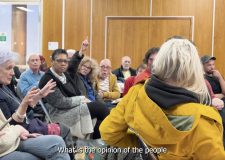Brighton and Hove transport chief maps out the road ahead
There’s good news and there’s bad news.
The good news is that the amount of money being spent improving the roads and pavements around Brighton and Hove is about to double.
The bad news is that it will involve more roadworks.
And a similar sum – more than £3 million – has been set aside for a series of major projects.
They are intended to make the city a better place and a safer place and a cleaner place.
But they too will involve roadworks.
It’s not that we can’t have our cake and eat it. It’s just that we’ll have a bit of a wait while the cake is baking.
And with the new financial year about to start, Ian Davey, the council cabinet member for transport and the public realm, has been taking stock.
He has set out the details of five big projects which, he believes, will define the Greens’ stewardship of Brighton and Hove City Council. They are
- the Old Shoreham Road cycle lane
- Lewes Road bus and cycle lanes
- the Station Gateway
- Valley Gardens
- a revamp of the Seven Dials
The last of the five will undoubtedly prompt a lively debate.
“It is,” Councillor Davey said, “an accident blackspot and a bit of a nightmare for everybody. It literally severs communities.
“The challenge is to address the road safety issues while creating a space that works better for everybody. We will start by talking to local communities over the next few months.”
The first on the list – the Old Shoreham Road cycle lane – is nearing completion.
 Councillor Davey said that the official opening date was expected to be Monday 18 June – the start of Bike Week.
Councillor Davey said that the official opening date was expected to be Monday 18 June – the start of Bike Week.
But he expects to see it being used in May if the contractors stay on schedule.
Like the cycle lanes in The Drive and Grand Avenue, it has had its detractors. He emphasises that it’s all about making it safer and easier for people to make healthier, cleaner and more sustainable choices when they travel around town.
In this year’s budget money has been set aside to make the crossings safer for people on foot and bike at the Old Shoreham Road junctions with The Drive and The Upper Drive. Both are used by hundreds of school children every day during term time.
The junction of Cromwell Road and The Drive is also in line for a safer set of traffic lights like those installed at the next two junctions down.
Lewes Road
Proposals for Lewes Road are taking shape, with a huge consultation exercise due to start next month on the £6.5 million scheme.
The council is putting in £250,000 a year over the next two years with £4.2 million coming from the government’s sustainable transport fund.
A further £2.25 million is coming from other local organisations including Brighton and Hove Buses, Sussex University, Brighton University and Brighton and Hove Primary Care Trust.
A formal decision to proceed was taken this afternoon (Tuesday 27 March) in Councillor Davey’s absence by his Green cabinet colleague Pete West.
Councillor West approved separate bus and cycle lanes and plans to make it safer at the Vogue Gyratory.
It has previously been flagged up as having poor air quality because of congestion, as well as a poor safety record for accidents.
Fifty parking spaces are due to be taken out of Lewes Road north of the Vogue Gyratory to ensure that the lanes for cars, buses and bikes will allow the traffic to flow properly.
Councillor Davey said: “The cycle lane north of the Vogue Gyratory was great for the time but is inadequate for the number of people who want to use it now.
“The Vogue Gyratory is a road junction from another era. Most people recognise that something needs to be done to make it better for everybody.”
Jo Walters
The death of student teacher Jo Walters in 2010 has added impetus to efforts to improve the routes used day in day out by thousands of students on foot and bicycle.
Jo’s sister Lucy Johnston is chairman of the Jo Walters Trust, which carried out its own study of part of the route.
She said: “After my sister was killed when cycling in the Lewes Road area, the Jo Walters Trust, which is run by Jo’s friends and family, commissioned a report to understand what could be done to ensure future cyclists could cycle in the area safely.
“One of the main recommendations of this report was that one of the lanes of the A270 would become a bus lane, with a cycle lane next to it.
“Given that the traffic on this road has decreased significantly since the opening of the bypass, this should be a relatively inexpensive and simple solution to ensure that cyclists are kept further from the busy traffic on that road.
“The Jo Walters Trust fully endorses the plan as a good solution to avoid any similar tragedies to the one that befell Jo, an issue of growing importance given the rising volume of cycling between the city and the schools, universities and sports facilities in the Falmer area.”
Valley Gardens
An early version of the Valley Gardens project was suggested six years ago when Labour ran the council.
It is back on the drawing board with more than £1 million budgeted over the coming three years.
The scheme should build on the revamp of The Level and create a more pedestrian-friendly park from The Level to the sea.
Councillor Davey said: “We’re looking to have a design to put out to public consultation this year or in early 2013 with a view to starting to build something in 2014.
“It’s a big area and it will take years to builds the whole scheme. It’s part of a long-term vision to have a city centre park from The Level to the sea – we can’t ignore the Aquarium roundabout – and I’m pleased we’ve got cross-party support.”
The Station Gateway project is also expected to start gathering pace over a similar timescale.
His officials will also start talking to Network Rail, the train operator Southern, representatives of the bus company and the taxi trade as well as people living and working around Brighton Station soon.This will happen as the initial proposals are refined.
While the front of the station will be the most visible part of this project, Councillor Davey is keen to make it easier for people to reach the North Laine and the London Road shops.
And there’s more
About £1 million is about to be spent on bridges and structures such as retaining walls, including the seafront arches in King’s Road and the Marina tunnel.
Work will start at the West Pier end in anticipation of work starting on the i360.
And nearly £1 million will be used to upgrade street lighting to reduce the need for constant repairs.
A number of areas will get new lamp posts and more energy-efficient bulbs should cut bills and reduce the city’s carbon footprint.
Councillor Davey said: “We want to get the city moving by using various forms of travel, helping people who drive, walk, cycle or use public transport.
“At the same time we’re striving to cut the serious levels of air pollution in some locations and reduce the numbers of people killed and injured on the roads.”
He expects to hear many and varied views, often deeply held, on many if not all of these big projects.
He has had a taste of what to expect while trying to decide how far parking zones should extend and how much parking charges should be.
But the test, he said, was simple: “It’s a city that looks better, works better and feels better.”
The cost
The council bids for money from the government to spend on transport projects including the upkeep of our roads and pavements.
The bid is made through the Local Transport Plan (LTP). The government grants are not ring-fenced, though, so councils do not always allocate them as intended.
Here are the figures for the transport capital budget for the past few years and for the next few too
2009-10 Government grant £6.038 million
Allocation by council £5.79 million
2010-11 Government grant £6.521 million
Allocation by council £3.019 million (reduced during the year by £1.239 million after government cuts)
2011-12 Government grant £5.953 million
Allocation by council £3.335 million
2012-13 Government grant £6.576 million
Allocation by council £6.456 million (Labour budget amendment transferred £120,000 to fund a replacement mobile library)
2013-14 Government grant £6.349 million (subject to change)
2014-15 Government grant £7.479 million (subject to change)
Ian Davey said that the Greens had effectively ring-fenced transport spending despite the financial pressures being faced by the council.
In the final Conservative budget, £3.3 million was set aside for transport projects, from a government grant of almost £6 million.
In the Greens’ first budget the sum went up to £6.5 million with £3.4 million being budgeted for highways maintenance and renewal alone.
Councillor Davey said: “Investment in our infrastructure is very important for this city.”




















